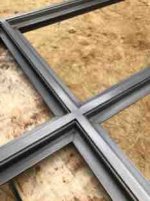Whetstone
Cast Iron
- Joined
- Mar 27, 2011
- Location
- Providence RI
Semi-Automated drilling machines
Im looking to build or buy a semi auto drilling machine to help produce some recurring projects. We are an architectural fabrication shop and the products in question are custom doors that utilize a lot of mechanical fasteners on lengths of material upto 8’ long. One door could have 12 lengths of material that is peppered with drilled and coutersunk holes or corresponding tapped holes and all need to bolt together to form the door profile and end in perfect miters. Right now we have an order for 6 of these doors all slightly different dimensions. Material is all fairly light, bar stock, tubes and angles in steel, stainless and brass.
Currently these are laid out by hand and drilled on a drill press or a bridgeport. I am able to lay them out accurately, but my employees cannot or take way too long. We make variations of these doors regularly so I am looking at easier and more accurate solutions. Which leads me to my questions. I suppose these could be done on a CNC bed mill or VMC but I am totally unfamiliar with CNC with the parts getting indexed 2-3 times. Other deterrent of the CNC is overall complexity for both programing, setup and running, I am looking to set up a dead simple process.
The two directions I see going in is retrofitting a 96” Tigerstop to a Bridgeport or drill with a X-Y table. I can dial in the Y dimension of the hole on the Bridgeport and then make a simple program for the tigerstop to push the material to the appropriate stops. Tigerstops are not cheap so I would be looking at a $8000 minimum investment to set up an existing bridgeport. I like the idea of the Bridgeport retrofit as I can easily adjust Y dimensions and be able to angle the head which could be useful. The second option would be finding a used pre built auto drill line, but I would not even know where to begin to find one in decent shape and would be worried about it being overly complicated as we dont need a full auto set up.
Does anyone have any thoughts or recommendations for alternative ways to drill and tap these parts in a simple and accurate way?
Im looking to build or buy a semi auto drilling machine to help produce some recurring projects. We are an architectural fabrication shop and the products in question are custom doors that utilize a lot of mechanical fasteners on lengths of material upto 8’ long. One door could have 12 lengths of material that is peppered with drilled and coutersunk holes or corresponding tapped holes and all need to bolt together to form the door profile and end in perfect miters. Right now we have an order for 6 of these doors all slightly different dimensions. Material is all fairly light, bar stock, tubes and angles in steel, stainless and brass.
Currently these are laid out by hand and drilled on a drill press or a bridgeport. I am able to lay them out accurately, but my employees cannot or take way too long. We make variations of these doors regularly so I am looking at easier and more accurate solutions. Which leads me to my questions. I suppose these could be done on a CNC bed mill or VMC but I am totally unfamiliar with CNC with the parts getting indexed 2-3 times. Other deterrent of the CNC is overall complexity for both programing, setup and running, I am looking to set up a dead simple process.
The two directions I see going in is retrofitting a 96” Tigerstop to a Bridgeport or drill with a X-Y table. I can dial in the Y dimension of the hole on the Bridgeport and then make a simple program for the tigerstop to push the material to the appropriate stops. Tigerstops are not cheap so I would be looking at a $8000 minimum investment to set up an existing bridgeport. I like the idea of the Bridgeport retrofit as I can easily adjust Y dimensions and be able to angle the head which could be useful. The second option would be finding a used pre built auto drill line, but I would not even know where to begin to find one in decent shape and would be worried about it being overly complicated as we dont need a full auto set up.
Does anyone have any thoughts or recommendations for alternative ways to drill and tap these parts in a simple and accurate way?






